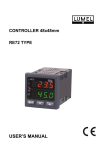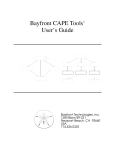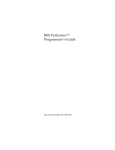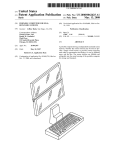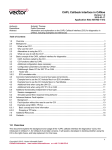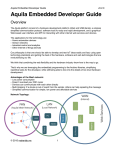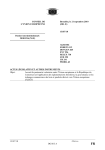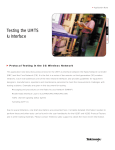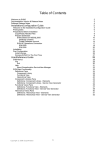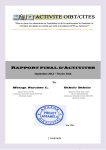Download DSS2 - TML
Transcript
1. DSS2
Author: Timo Pärnänen
There are two possible trends to implement ATM signalling protocols: according to
specifications by ATM Forum or by ITU-T. During the first year of TOVE project, an
user-network interface (UNI) layer 3 was implemented according to ITU-T
specifications. In the future, also network-network interface by ITU-T and some
specifications of ATM Forum will be implemented.
This implementation, Digital Signalling Subscriber No.2 (DSS2), is based on ITU-T
standard Q.2931. It specifies the user-network interface for basic call/connection control
in Broadband Integrated Services Digital Network (B-ISDN). Part of the specification
was implemented in the call control module (see the call control documentation).
2
Architecture
Q.2931 specification consist of four modules: co-ordination, reset-restart, reset-response
and actual Q.2931 signalling protocol. In the first release, the co-ordination and Q.2931
module were implemented. Both of these are placed in the same programming module (in
CVS, Concurrent Versions System) called dss2. The dss2 module includes following
classes:
•
dss2Protocol
•
dss2CoOrdProtocol
•
dss2State and inherited classes for all actual states in DSS2 state machine
•
dss2CoOrdBaseState and four inherited classes for actual states in co-ordination state
machine
•
dss2Pdus and inherited classes for each PDUs
•
eight primitive classes for requesting and indicating link status
•
dss2Accessor joined to the mux to get a call reference value from incoming PDUs
Figure 1 shows relations between objects.
From the switch's point of view there are two sides of the DSS2 protocol, originating and
terminating sides. The former one receives the SETUP message from down direction or
from the IN architecture and starts call, the latter one sends the message to the destination
(to the next switch or user) equipment. An appendix X has signalling diagram examples
of call/connection establishment and clearing.
C C P ro to co l
C C /D S S 2 F acto ry
C u rren t S tate
D S S 2 P ro to co l
d ss2 A ccesso r
C o n n ectio n M u x
C o -o rd in a tio n
en su res th a t lin k is in
w o rkin g a n d it a lso
en co d es a n d d eco d es
D SS2 PD U s
C o -O rd in atio n
P ro to co l
C u rren t S tate
M ux has a
m a p (S T L ) w h ich
a llo ca tes a n d
h a n d les ca ll
referen ces o f
co n n ectio n s
Figure 1 Relations between objects
!"!#$%$&'#)(!$%*&+
Following chapters describe some special issues related to the implementation of the
DSS2 protocol, states and messages. Because implementation is based on the OVOPS++
architecture, common implementation solutions are not documented here. These can be
found from the OVOPS++ documentation.
1.2.1 3.1
Protocols and states
The DSS2 protocol accepts primitives from a call control via sigiface, correspondingly
the co-ordination protocol accepts primitives from lower uni-sscf layer via uaaliface.
Through the local "interface" between the DSS2 and co-ordination protocol, PDUs and
few link control primitives are transferred.
The DSS2 and co-ordination protocol class includes all protocol variables and a pointer
to the current state. The protocol has methods (interface) to send primitives and PDUs to
upward and downward. The purpose of the co-ordination protocol is to ensure that link is
up. It also decodes PDUs from incoming lower layer primitives and correspondingly
encodes PDUs to outgoing primitives to down direction.
States are implemented in a bit different way like in other protocols of the TOVE project.
In fact differences are in state changing methods. The reason why state changing is
different is that we want use same states in many signalling protocols. Now it is used
only in the Q.2931 network and user side, but in the future these same states will be used
for UNI 3.1/4.0. The DSS2 network and user side have very few differences between
themselves. User side states U0, U6, U9 for example correspond to network states N0,
N1, N3. The state changing from outgoingCallProceeding (N3) state to the active state is
different in the user side (U9 , U8). There is one state more in the user side in this
situation. Figure 2 shows that change from callInitiated state to outgoingCallProceeding
state is equal in both sides, but change from outgoingCallProceeding to the active state
differs.
dss2Protocol
dss2Mode
changeToOutgoingCallProceeding(protocol *)
changeToActive(protocol *)
changeToActive(protocol *)
8b.
5b.
4.
5a.
dss2State
dss2NetworkMode
dss2UserMode
changeToActive(protocol *)
changeToActive(protocol *)
6a.
dss2OutgoingCallProceeding
// changeToActive
2.
changeToOutgoingCallProceeding(protocol *)
changeToActive(protocol *)
6b.
dss2Active
7b.
1.
dss2UConnectRequest
dss2CallInitiated
changeToActive(protocol *)
// changeToOutgoingCallProceeding
changeToActive(protocol *)
3.
Figure 2 State changing
A following list describes stages shown in the figure 2.
1.
changeToOutgoingCallProceeding method is called from dss2 base state
2.
the method call is delegated to the protocol
3.
changeToActive method is called from outgoingCallProceeding itself (rewritten
method)
4.
the method call is delegated to the mode class instead of the protocol
5.
the method call is directed to the actual inherited mode class
6.a. in the network side state is changed direct to the active state
6.b. in the user side state is changed to the connectRequest state
7-8. state change from connectRequest state to the active state corresponds steps 1 and 2
In the outgoingCallProceeding state, changeToActive method has rewritten, which
doesn’t call the real state changing method from the protocol but from the mode object.
States are implemented using a singleton pattern as normally. A figure 3 shows state
hierarchy and relations between DSS2 and co-ordination states.
p fS ta te
s ig D o w n In p u ts
u a a lU p In p u ts
d s s 2 S ta te
1 1 d s s 2 -s ta te s
d s s 2 C o O rd B a s e S ta te
4 c o O rd -s ta te s
Figure 3 The state hierarchy.
The dss2State is a base state for the protocol state machine. It is derived virtually from
uaalUpInputs and sigDownInputs whose are abstract base classes defined in upper and
lower interfaces. These abstract classes inherit state machine features of the framework
from the pfState base class. Actual DSS2 states and a base state for the co-ordination
protocol are derived from dss2State. The dss2CoOrdBaseState is derived from dss2State
because it has some same inputs (PDU inputs) than in DSS2 and it helps error handling
for inherited co-ordination states.
1.2.2 3.2
Messages and information elements
PDUs are composed of information elements. In our DSS2 implementation PDUs have a
common base state which includes information elements as attributes. The PDU base
class have also encoding and decoding functions for all information elements. In that way
derived PDU classes are very small because only few PDUs have the special actions like
error handling actions (e.g. if invalid information element occurs). Figure 4 shows a
message hierarchy. PDUs are derived from pfMessenger and tvBitHandler which is a
special class for handling bit operations. It has methods to put/get bits to/from the frame.
This helps to implement encoding and decoding functions and makes them simply,
especially in DSS2 because almost all information elements consist of small (one to three
bits) fields.
Information elements are located in the siginfo module. Classes in that module
implement information element fields and methods for handling them. In the base class of
information elements have methods for checking if the information element is mandatory
or is it allowed at all in the PDU in question. Appendix Y has a figure of the DSS2 PDU
format. First nine octets are common for all DSS2 PDUs and each information elements
have four common octets at the begin of them.
Normally information elements or fields of them are copied from a PDU to a primitive to
up direction (call control). But in the case of SETUPpdu a pointer to the PDU is copied to
the primitive, so all information in the PDU are transferred also to the call control.
pfMessenger
tvBitHandler
// Bit operators
dss2Pdus
// Base class for
// PDUs
PDUs
ccInfo
// Base class for
// information elements
Information
Elements
Figure 4 Message hierarchy
-./0123*45
6728:9;< =2;)2*>
42*?
In the first release only mandatory (the minimal amount of elements for call/connection
establishment and clearing procedures) information elements were implemented. The
following list shows implemented information elements. All of them have coding
functions, but some information elements are not used in the first release of the software.
•
Called party number. Maximum length (network dependent) is not checked when
decoding.
•
Called party sub-address. Odd/even indicator not used.
•
Restart indicator (not used )
•
ATM traffic descriptor (not used )
•
Connection identifier
•
Quality of Service parameter (not used )
•
Broadband bearer capability (not used )
•
Call state
•
Cause. Diagnostics field is not supported, but it will be decoded out from frame if
presents.
An interface (sigif) between the DSS2 and the call control is of course insufficient and
not very robust because of reasons mentioned above.
Next list shows other not implemented features in the first release:
•
reset-start, reset-response modules
•
additional PDUs. Interworking with 64 kbit/s ISDN.
•
explicit error handling. Only normal error handling present.
•
timers. All timers in the DSS2 and co-ordination protocol are not implemented.
•
cause value is not set in all possible places.
@ABCDFEGIHJE)KLM
N:O*E
P"QSROTHJN
There is one flaw founded in decoding functions of DSS2 information elements. Fixing
of this could be taken quite lot of time because it may cause some general changes to
DSS2 information element decoding functions.
If an information element which have optional fields is in the last one in a frame, it could
be decoded wrong. This can happen when decoded information element length field
doesn’t match to the frame length but indicated length is enough long for mandatory
fields. So the very last information element in the frame will be accepted even if
information element’s length value is greater than the length of octets left in the frame.
The consequences are : information element is accepted and last fields are set to zero (if
frame is empty the return value of a getFirst method is zero) but error isn’t noticed.
UVWYXZ[\[
]7^`_^
ab^cdfeIg"^h\
When a data communication software is designed and implemented not all details can be
considered at first time. When object-oriented programming is used, it’s easy to develop
the software again and make it clearer and more efficient by modifying the old code.
Following chapters describe problems and some ideas to solve them founded in the first
programming phase of the Q.2931.
1.5.1 6.1
Co-Ordination
At the very first implementation, a problem occurs when a decoded PDU arrived in the
mux. If a call reference of the PDU doesn’t match any of values stored in the mux and the
PDU is not a SETUPpdu or a call reference flag of SETUPpdu was set incorrectly, the
PDU stayed at the mux and because it didn’t reach any protocol it will never be deleted.
The co-ordination should also send a STATUSpdu to downward. The solution for the
problem that how co-ordination knows the final destination of PDU was boolean flag in a
transporter. The flag was checked at the co-ordination when the method call returned.
Because the previous solution wasn’t very nice, the implementation was modified so that
the co-ordination protocol has a pointer to the mux implementation. Now the coordination can check the call reference before it sends PDU to the mux and it knows the
final target of the PDU. But an idea of the OVOPS++ is to use proxies to
implementations and doesn’t let any other conduits to use direct implementations of other
conduits. That is why major idea for the solution of this problem in next release is that
the mux and the co-ordination will be combined together. Then the co-ordination is same
time the protocol with a state machine and the mux with an accessor. More about this
idea can be founded from the OVOPS++ documentation.
ijkkjl
monn*pqq:rs)tu
vswx)y*rtsu)pzpx)p*ur
vtpz{q
The PDU consist of information elements and each of them are composed of many fields
(usually long integer values) as figure 4 showed. Because the lack of time to implement a
better solution, information elements are now as publics in the PDU base class.
Information element fields can be used direct from information element when the pointer
to the PDU is available.
pdu | _connectionId.getVCI();
Better solution would be that the PDU has methods whose delegate access method calls
to information elements.
pdu } getVCI();
But this implementation way will cause that the PDU will have several tens of methods
(access methods for every fields in every information elements). The future solution may
be founded in design patterns using visitors and double dispatching to find the right field
from the right information element without tens of methods in the PDU.
Same experiences can be used to think structure of primitives in a sigiface and copying of
parameters between PDUs and primitives.
~
F
*
F
TJ
*
It seems that identifying of PDUs and information element types, when decoding PDUs,
can’t be handled by any object-oriented ways and it should be solved with a switch-case
structure. But one idea, is based on STL Map, was founded. Now information element
objects are as attributes in the PDU. They also could been stored to STL Map with an
identifier as key. When the identifier is decoded, the right information element is founded
with the identifier from the map and then the right decode method can be called from the
information element object instead of using the switch-case statement.
Problems may be occurred if more than one information element are instances from the
same class. For example a called party number and a calling party number are both
instances from phoneNumber class, but they have different coding functions. In the
above idea decode method was called from the object founded in the map with the
identifier, but here we need two decoding methods.
Y*S*
Following table 1 shows hours used to implement modules related to DSS2 (table 2). It
also contain hours used for a general codec module. Researching and implementing of
some test prototypes have been taken also lots of time because of many new
programming methods were used.
Activity
Research
Design
Coding
Reviews
Total
Duration (h)
170
200
590
0
960
Table 1 Duration of activities
Following table 2 shows statistics of the code related to an implementation of DSS2
specification. A siginfo module contains information elements and a sigif module
contains primitive classes for the upper interface of the DSS2.
Module name
Lines Of Code (LOC)
Number of files
Number of classes
DSS2
5552
53
54
SIGINFO
825
3
11
SIGIF
1375
4
34
Table 2 Metrics
¡¢F£¤£¥7£¦§£*¨
Object Space Inc., Systems<ToolKit> UNIX Reference Manual, 1994-1995.
Object Space Inc., Systems<ToolKit> UNIX User’s Manual, 1994-1995.
ITU-T Recommendation Q.2931, 1995.
TOVE project, OVOPS++ document.
Gamma, E., Helm, R., Johnson, R., Vlissides, J., Design Patterns, Elements of ObjectOriented Software, Addison-Wesley, 1995.
©ª©b«¬¯®® °±²³µ´·¶
CO-ORD
U-SSCF
CC
DSS2
DSS2
U-SSCF
CO-ORD
DATAind
SETUPpdu
SETUPind
PROCEEDINGreq
PROCEEDINGpdu
SETUPreq
DATAreq
SETUPpdu
DATAreq
DATAind
PROCEEDINGpdu
DATAind
PROCEEDINGind
CONNECTpdu
SETUPconf
SETUP_COMPLETEreq
SETUPresp
CONNECT_ACKpdu
CONNECTpdu
DATAreq
DATAreq
DATAind
CONNECT_ACKpdu
Figure 2 Normal call/connection establishment from the switch point of view.
CO-ORD
U-SSCF
DSS2
CC
DSS2
CO-ORD
U-SSCF
DATAind
RELEASEpdu
RELEASEresp
RELEASE_COMPLETEpdu
RELEASEreq
RELEASEpdu
DATAreq
DATAreq
DATAind
RELEASE_COMPLETEpdu
RELEASEconf
Figure 3 Normal call/connection clearing from the switch point of view
¸¹¸¸»º¯¼¼ ½¾¿ÀµÁ·ÂÂ
Protocol Discriminator
Length of call reference value
Flag
Call reference value
Message Type
Ext
Spare
Flag
Spare
Msg.Action
Indicator
Message Length
Information Element Identifier
Ext
Coding
Standard Flag
IE Instruction Field
Res.
IE Action Ind.
Length of Contents of
Information Element
Contents of Information Element
Figure 4 DSS2 message format











